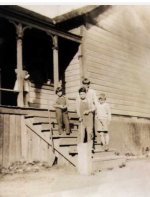The BC Adventure 10

By jeand
- 1487 reads
Jan 15, 1921
Dear Daddy,
Peter has started at the local school called North Vesuvius School. It is tiny with only 8 students, all in one room. It is near the jail, which Peter always comments on when we take him there.
You asked for particular information about the history of Salt Spring Island, so I am dedicating this letter to you, having done the research for you at the local museum.
Apparently the first non Indian settlers here were actually black people, in 1858, on the escape from racism. The leader Mister Biggs traveled up to talk to the Governor about what kind of treatment they could expect here, and he said that the Canadians treated everyone fairly, as slavery had been abolished 20 years earlier. And that group settled right here in Vesuvius.
I copied this out from a publication of 1895, 25 years ago, but might still be more or less accurate. It shows what an international place it was. The Anglican minister wrote:
"The present population of the island is estimated to be 450. A large number of different nationalities are represented. There are approximately, old and young, 160 English (or Canadians), 50 Scotch, 20 Irish, 22 Portuguese, 13 Swedes, 4 Germans, 2 Norwegians, 34 Americans, 90 Halfbreeds, 40 Colored, or partly colored people, 6 Sandwich Islanders [Hawaiians], 10 Japanese, also 1 Egyptian, 2 Greeks, 1 Patagonian."
Australians, Americans, and Europeans came to Canada in search of gold. The early settlers also included a number of former Hudson's Bay Company employees, including several Hawaiians who
had been brought to the Pacific Northwest by them; Japanese came as fishermen and labourers; and the more affluent immigrants were from the British Isles.
I also found from a document of 1905 that there were 80 documented farms and the main crops were fruit like apples, pears and strawberries and tomatoes. In 1904 Salt Spring Island Creamery was formed so along with dairy products, the other industries are mainly poultry and sheep farming.
The highest mountain is called Bruce Peak and is 2326 ft above sea level. We haven't been there yet. There are lots of hiking trails, and we do intend to do exploring once we are settled and the weather has improved somewhat. I would say the winter weather here is better than you have in Wales, in that there is less snow and it doesn’t last as long.
Some call it a Mediterranean climate due to the plant life: low growing Manzanita bushes, towering Arbutus trees grow in abundance. One species of indigenous cactus can apparently even be found growing on open sunny south-western slopes.
The other islands in this group are close enough to canoe to, and others have talked about going to Goat Island to pick special brown chocolate lilies.
Apparently they decorate all the churches with them at Easter.
Love,
Gwenllian
- Log in to post comments
Comments
Yet another informative piece
Yet another informative piece of writing Jean.
Very much enjoyed reading.
Jenny.
- Log in to post comments
Interesting to see the range
Interesting to see the range of places the community originated from, and that the climate is quite warm. I liked the sound of being able to hike up the mounain, and canoe to the nearby islands. I had never heard of brown chocolate lilies.
Peter's comment about the school reminded me of our local newly rebuilt primary school that my husband feels looks like a jail, and also of a photo my son took of his daughter, Ruth, by the notice saying 'Ruthin jail' (Ruthin is a place in north Wales – 'Ruth in jail') I don't think she appreciated the family joke at the time! Rhiannon
- Log in to post comments


